cooling CHRYSLER 300 SRT 2013 2.G User Guide
[x] Cancel search | Manufacturer: CHRYSLER, Model Year: 2013, Model line: 300 SRT, Model: CHRYSLER 300 SRT 2013 2.GPages: 580, PDF Size: 4.26 MB
Page 495 of 580
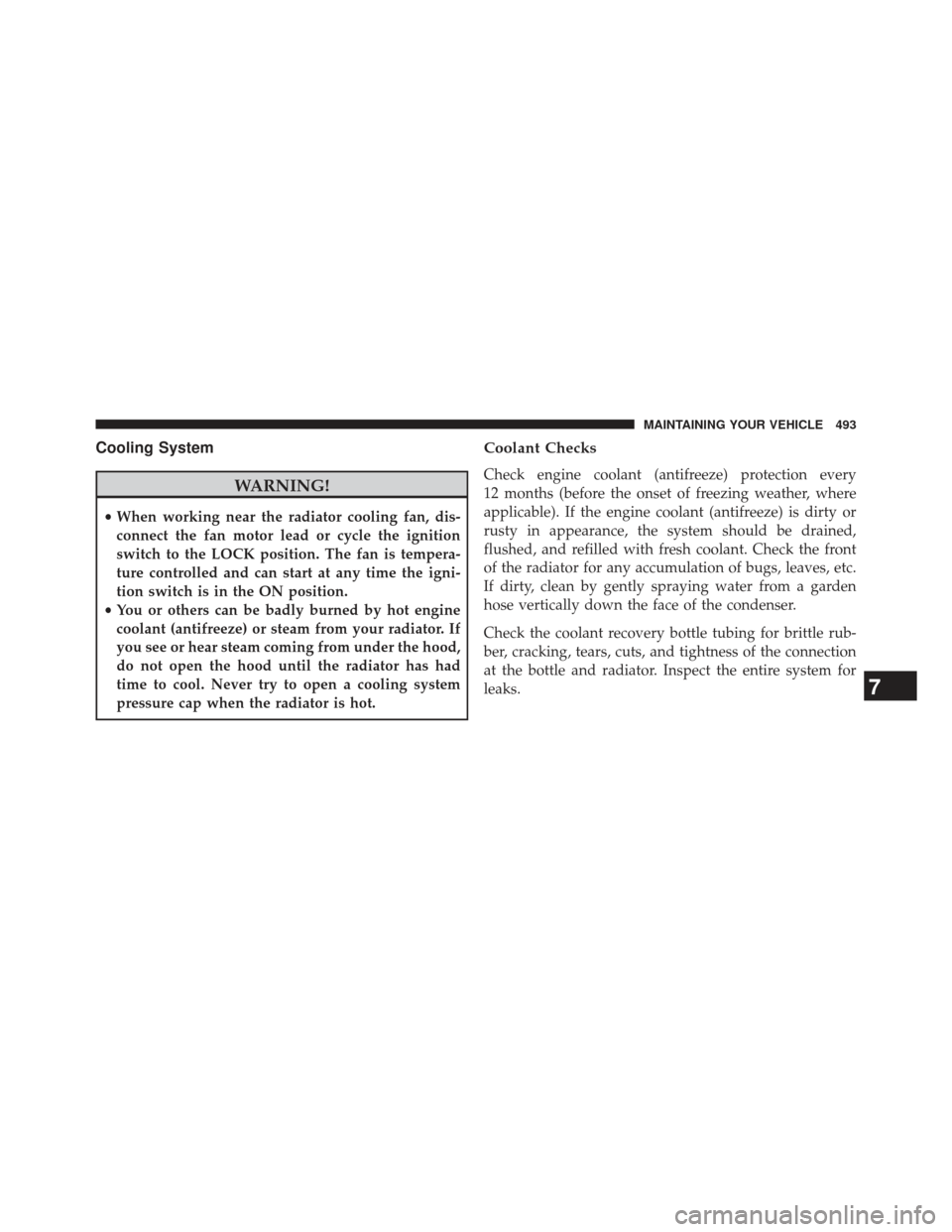
Cooling System
WARNING!
•When working near the radiator cooling fan, dis-
connect the fan motor lead or cycle the ignition
switch to the LOCK position. The fan is tempera-
ture controlled and can start at any time the igni-
tion switch is in the ON position.
• You or others can be badly burned by hot engine
coolant (antifreeze) or steam from your radiator. If
you see or hear steam coming from under the hood,
do not open the hood until the radiator has had
time to cool. Never try to open a cooling system
pressure cap when the radiator is hot.
Coolant Checks
Check engine coolant (antifreeze) protection every
12 months (before the onset of freezing weather, where
applicable). If the engine coolant (antifreeze) is dirty or
rusty in appearance, the system should be drained,
flushed, and refilled with fresh coolant. Check the front
of the radiator for any accumulation of bugs, leaves, etc.
If dirty, clean by gently spraying water from a garden
hose vertically down the face of the condenser.
Check the coolant recovery bottle tubing for brittle rub-
ber, cracking, tears, cuts, and tightness of the connection
at the bottle and radiator. Inspect the entire system for
leaks.
7
MAINTAINING YOUR VEHICLE 493
Page 496 of 580
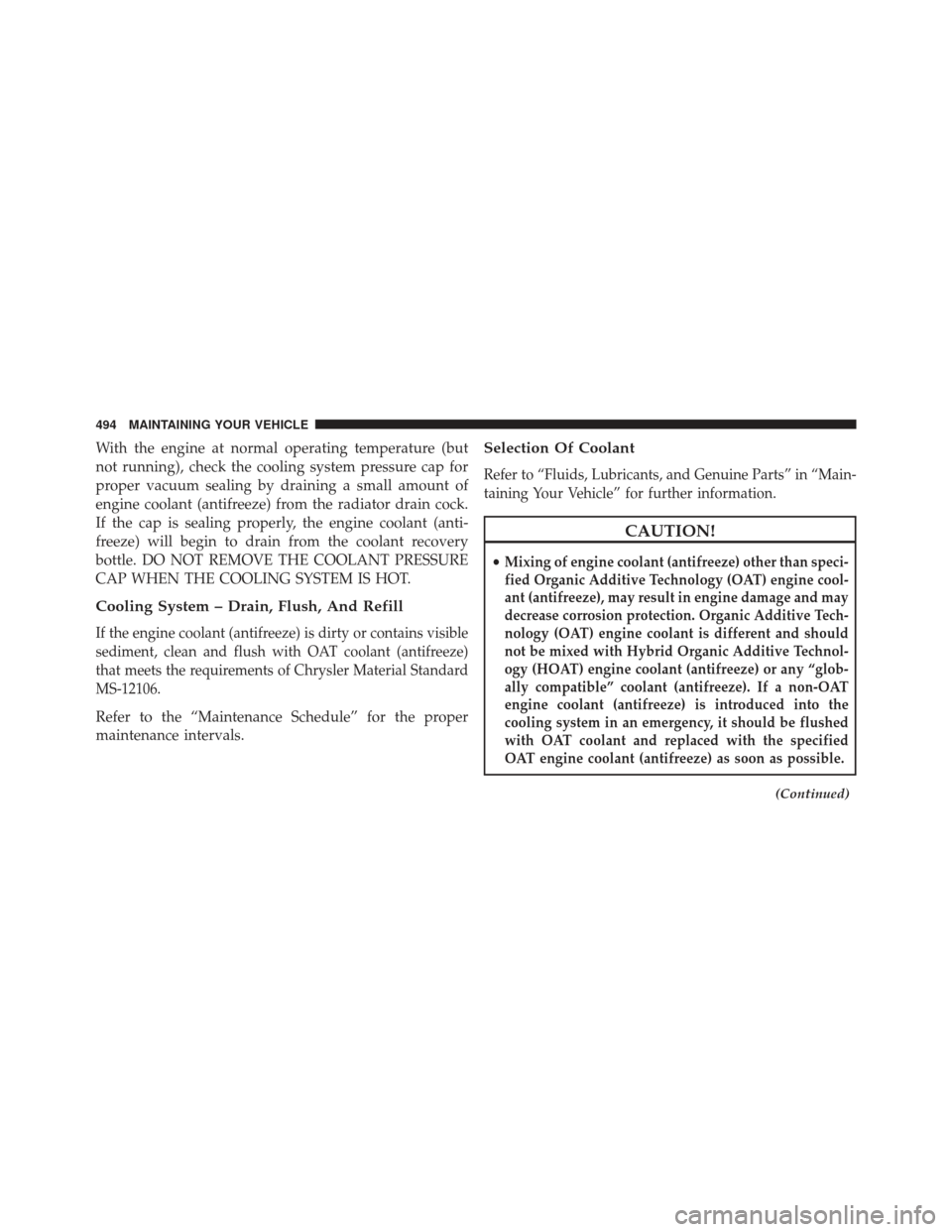
With the engine at normal operating temperature (but
not running), check the cooling system pressure cap for
proper vacuum sealing by draining a small amount of
engine coolant (antifreeze) from the radiator drain cock.
If the cap is sealing properly, the engine coolant (anti-
freeze) will begin to drain from the coolant recovery
bottle. DO NOT REMOVE THE COOLANT PRESSURE
CAP WHEN THE COOLING SYSTEM IS HOT.
Cooling System – Drain, Flush, And Refill
If the engine coolant (antifreeze) is dirty or contains visible
sediment, clean and flush with OAT coolant (antifreeze)
that meets the requirements of Chrysler Material Standard
MS-12106.
Refer to the “Maintenance Schedule” for the proper
maintenance intervals.
Selection Of Coolant
Refer to “Fluids, Lubricants, and Genuine Parts” in “Main-
taining Your Vehicle” for further information.
CAUTION!
•Mixing of engine coolant (antifreeze) other than speci-
fied Organic Additive Technology (OAT) engine cool-
ant (antifreeze), may result in engine damage and may
decrease corrosion protection. Organic Additive Tech-
nology (OAT) engine coolant is different and should
not be mixed with Hybrid Organic Additive Technol-
ogy (HOAT) engine coolant (antifreeze) or any “glob-
ally compatible” coolant (antifreeze). If a non-OAT
engine coolant (antifreeze) is introduced into the
cooling system in an emergency, it should be flushed
with OAT coolant and replaced with the specified
OAT engine coolant (antifreeze) as soon as possible.
(Continued)
494 MAINTAINING YOUR VEHICLE
Page 498 of 580
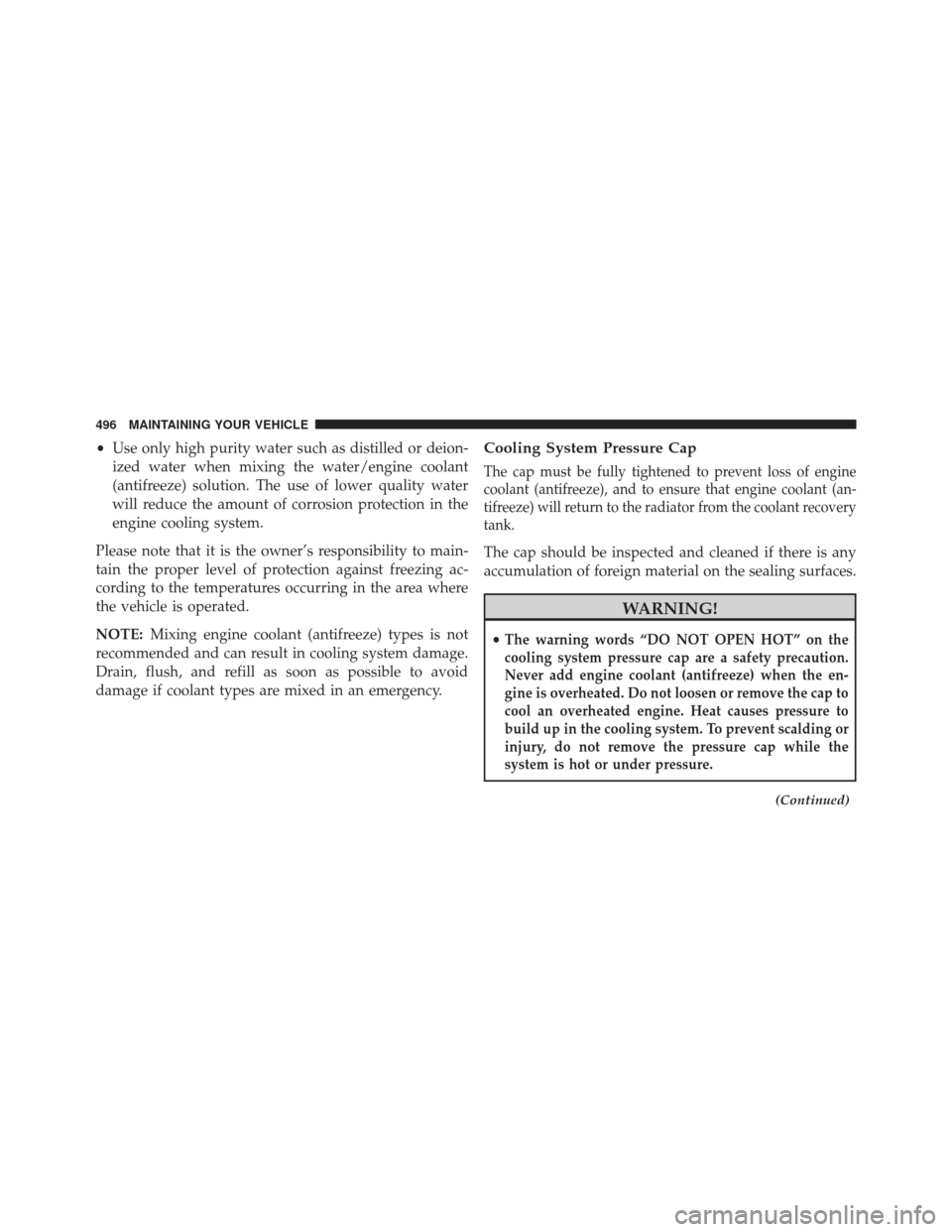
•Use only high purity water such as distilled or deion-
ized water when mixing the water/engine coolant
(antifreeze) solution. The use of lower quality water
will reduce the amount of corrosion protection in the
engine cooling system.
Please note that it is the owner’s responsibility to main-
tain the proper level of protection against freezing ac-
cording to the temperatures occurring in the area where
the vehicle is operated.
NOTE: Mixing engine coolant (antifreeze) types is not
recommended and can result in cooling system damage.
Drain, flush, and refill as soon as possible to avoid
damage if coolant types are mixed in an emergency.Cooling System Pressure Cap
The cap must be fully tightened to prevent loss of engine
coolant (antifreeze), and to ensure that engine coolant (an-
tifreeze) will return to the radiator from the coolant recovery
tank.
The cap should be inspected and cleaned if there is any
accumulation of foreign material on the sealing surfaces.
WARNING!
•The warning words “DO NOT OPEN HOT” on the
cooling system pressure cap are a safety precaution.
Never add engine coolant (antifreeze) when the en-
gine is overheated. Do not loosen or remove the cap to
cool an overheated engine. Heat causes pressure to
build up in the cooling system. To prevent scalding or
injury, do not remove the pressure cap while the
system is hot or under pressure.
(Continued)
496 MAINTAINING YOUR VEHICLE
Page 500 of 580
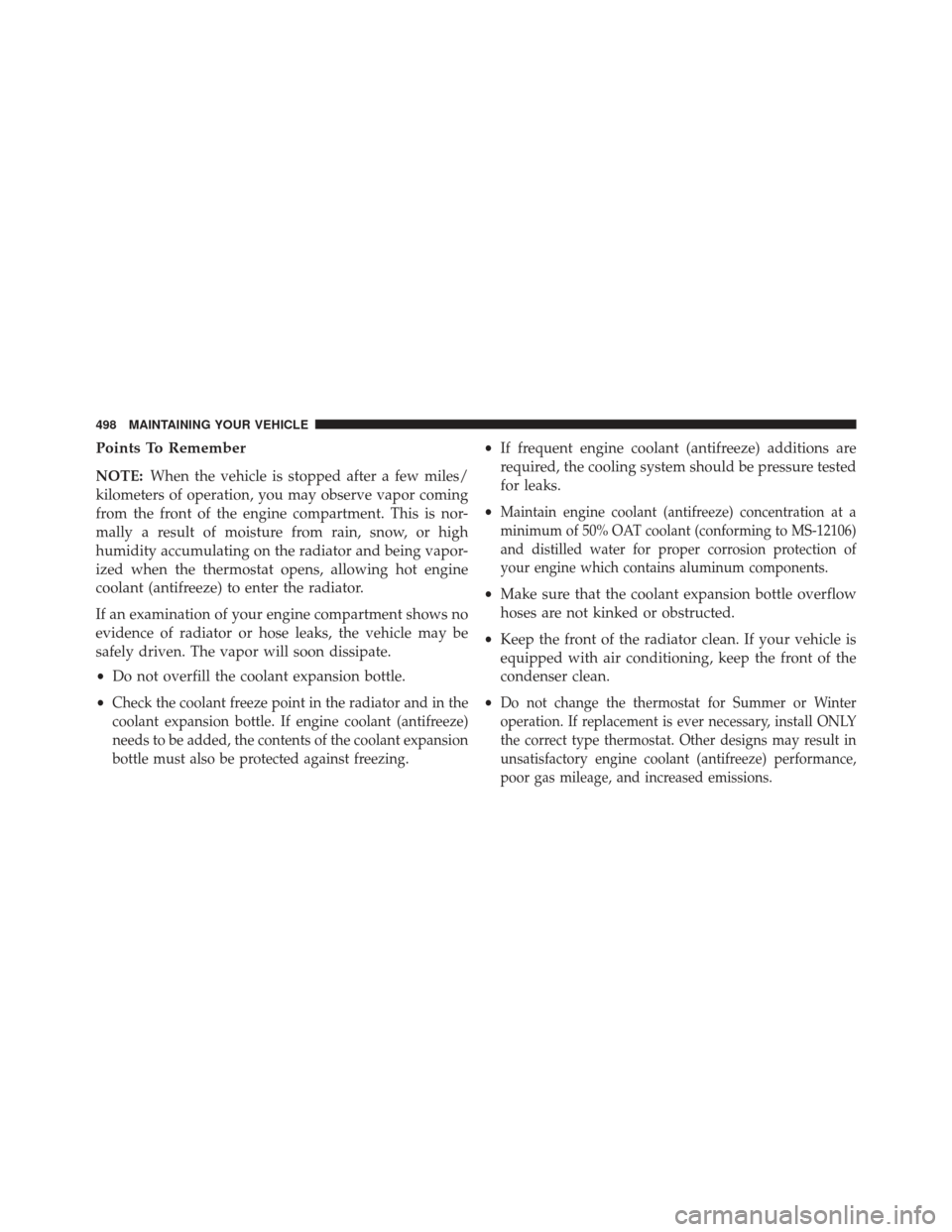
Points To Remember
NOTE:When the vehicle is stopped after a few miles/
kilometers of operation, you may observe vapor coming
from the front of the engine compartment. This is nor-
mally a result of moisture from rain, snow, or high
humidity accumulating on the radiator and being vapor-
ized when the thermostat opens, allowing hot engine
coolant (antifreeze) to enter the radiator.
If an examination of your engine compartment shows no
evidence of radiator or hose leaks, the vehicle may be
safely driven. The vapor will soon dissipate.
• Do not overfill the coolant expansion bottle.
•
Check the coolant freeze point in the radiator and in the
coolant expansion bottle. If engine coolant (antifreeze)
needs to be added, the contents of the coolant expansion
bottle must also be protected against freezing.
• If frequent engine coolant (antifreeze) additions are
required, the cooling system should be pressure tested
for leaks.
•
Maintain engine coolant (antifreeze) concentration at a
minimum of 50% OAT coolant (conforming to MS-12106)
and distilled water for proper corrosion protection of
your engine which contains aluminum components.
• Make sure that the coolant expansion bottle overflow
hoses are not kinked or obstructed.
• Keep the front of the radiator clean. If your vehicle is
equipped with air conditioning, keep the front of the
condenser clean.
•
Do not change the thermostat for Summer or Winter
operation. If replacement is ever necessary, install ONLY
the correct type thermostat. Other designs may result in
unsatisfactory engine coolant (antifreeze) performance,
poor gas mileage, and increased emissions.
498 MAINTAINING YOUR VEHICLE
Page 525 of 580
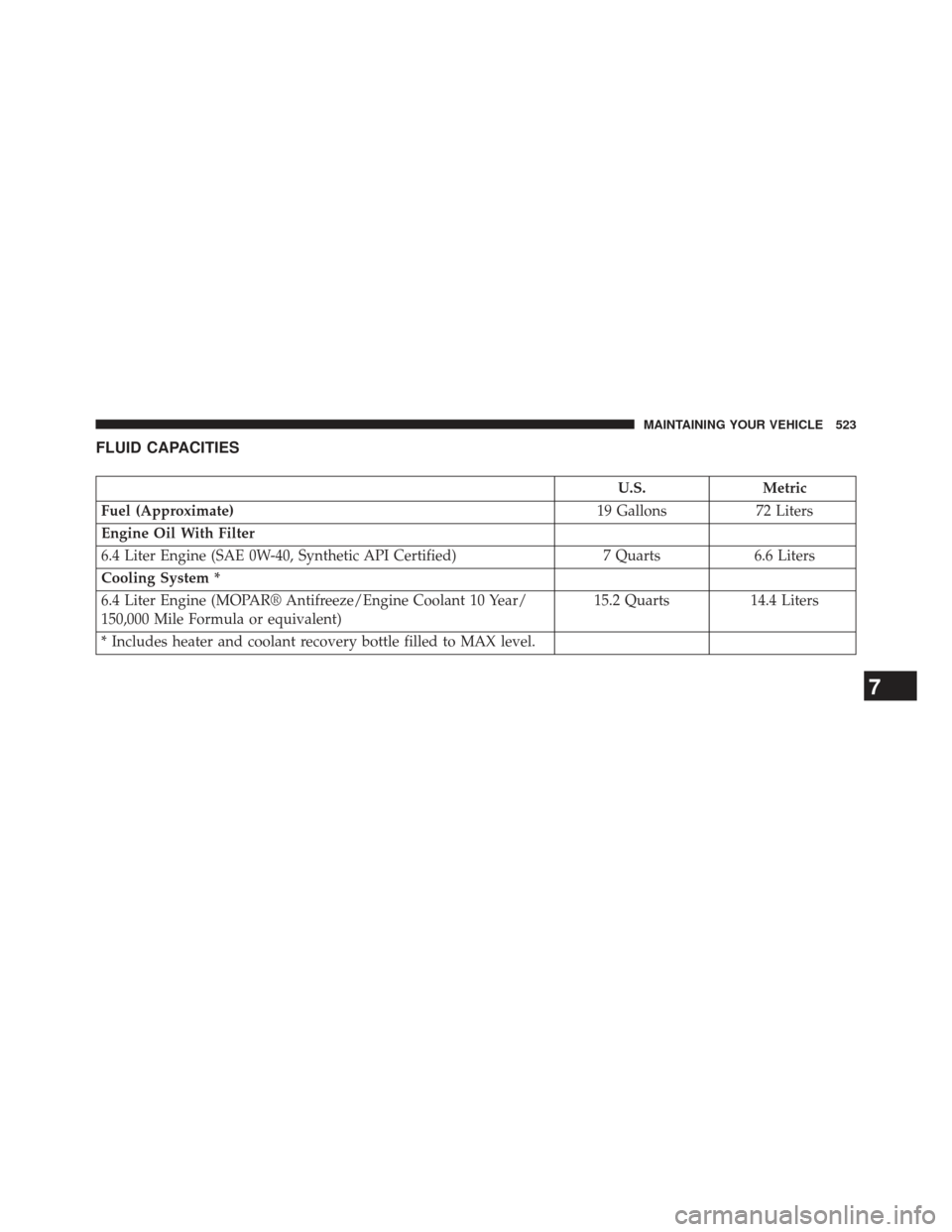
FLUID CAPACITIES
U.S.Metric
Fuel (Approximate) 19 Gallons72 Liters
Engine Oil With Filter
6.4 Liter Engine (SAE 0W-40, Synthetic API Certified) 7 Quarts6.6 Liters
Cooling System *
6.4 Liter Engine (MOPAR® Antifreeze/Engine Coolant 10 Year/
150,000 Mile Formula or equivalent) 15.2 Quarts
14.4 Liters
* Includes heater and coolant recovery bottle filled to MAX level.
7
MAINTAINING YOUR VEHICLE 523
Page 562 of 580
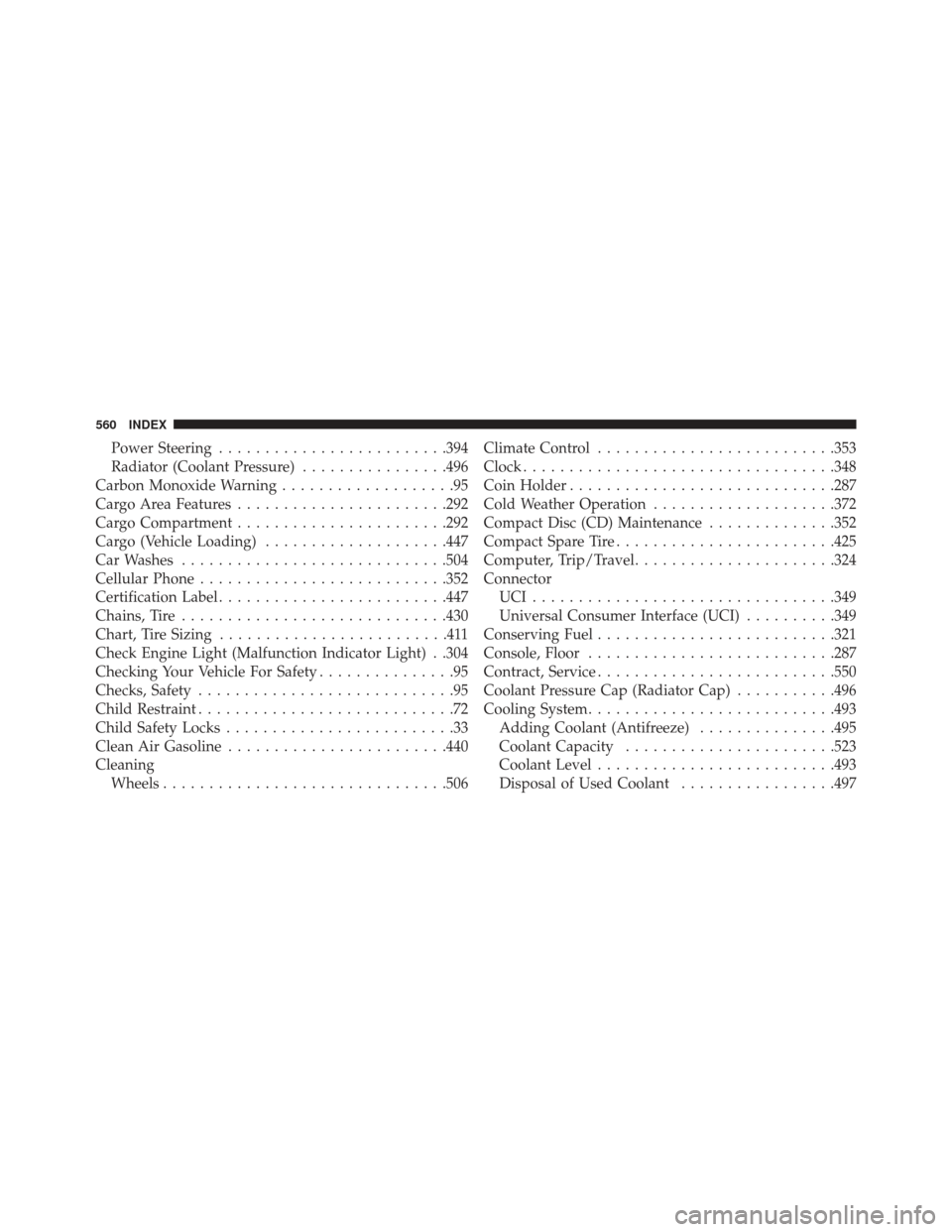
Power Steering........................ .394
Radiator (Coolant Pressure) ................496
Carbon Monoxide Warning ...................95
Cargo Area Features ...................... .292
Cargo Compartment ...................... .292
Cargo (Vehicle Loading) ....................447
Car Washes ............................ .504
Cellular Phone .......................... .352
Certification Label ........................ .447
Chains, Tire ............................ .430
Chart, Tire Sizing .........................411
Check Engine Light (Malfunction Indicator Light) . .304
Checking Your Vehicle For Safety ...............95
Checks, Safety ............................95
Child Restraint ............................72
Child Safety Locks .........................33
Clean Air Gasoline ....................... .440
Cleaning Wheels .............................. .506Climate Control
......................... .353
Clock ................................. .348
Coin Holder ............................ .287
Cold Weather Operation ....................372
Compact Disc (CD) Maintenance ..............352
Compact Spare Tire ....................... .425
Computer, Trip/Travel ..................... .324
Connector UCI................................ .349
Universal Consumer Interface (UCI) ..........349
Conserving Fuel ......................... .321
Console, Floor .......................... .287
Contract, Service ......................... .550
Coolant Pressure Cap (Radiator Cap) ...........496
Cooling System .......................... .493
Adding Coolant (Antifreeze) ...............495
Coolant Capacity ...................... .523
Coolant Level ......................... .493
Disposal of Used Coolant .................497
560 INDEX
Page 564 of 580
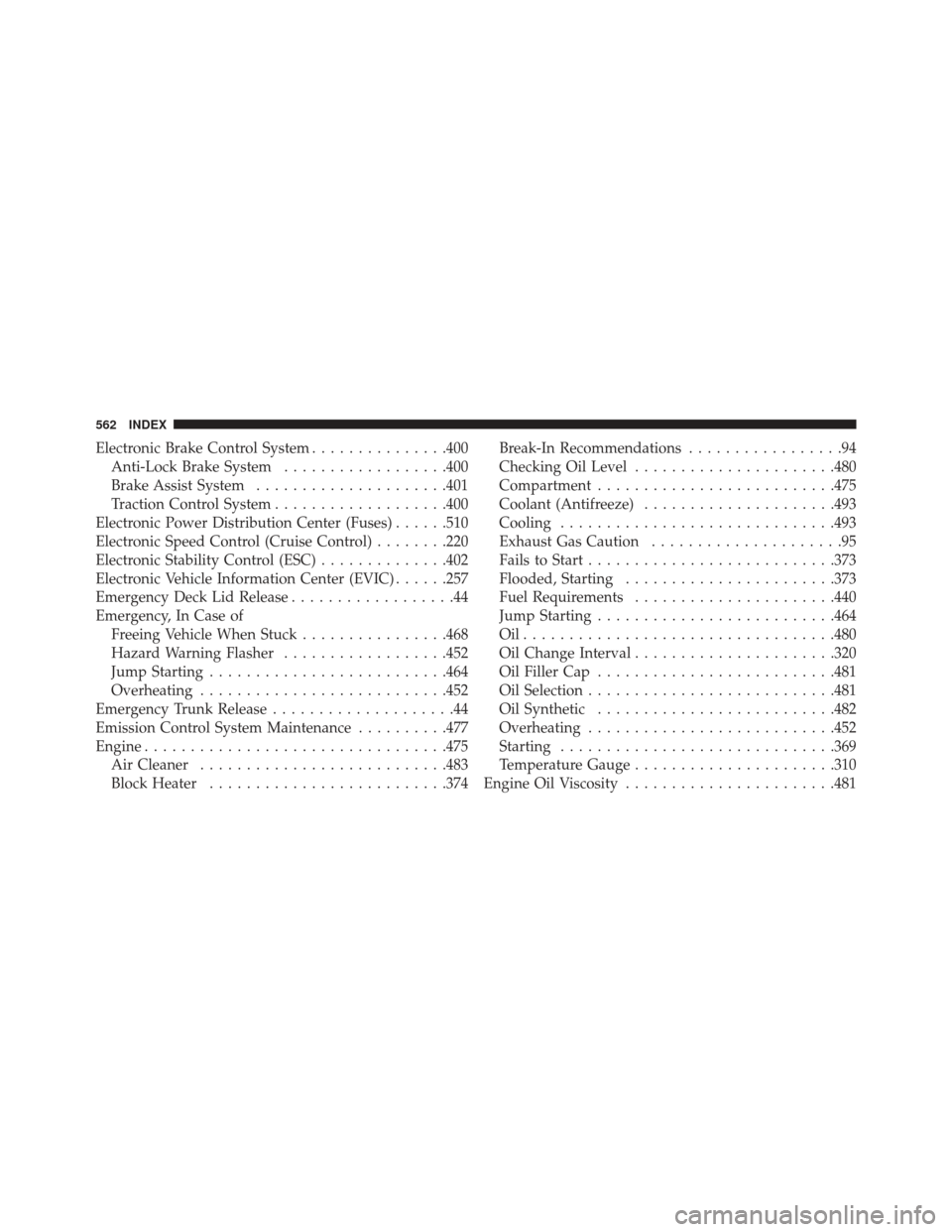
Electronic Brake Control System...............400
Anti-Lock Brake System ..................400
Brake Assist System .....................401
Traction Control System ...................400
Electronic Power Distribution Center (Fuses) ......510
Electronic Speed Control (Cruise Control) ........220
Electronic Stability Control (ESC) ..............402
Electronic Vehicle Information Center (EVIC) ......257
Emergency Deck Lid Release ..................44
Emergency, In Case of Freeing Vehicle When Stuck ................468
Hazard Warning Flasher ..................452
Jump Starting ......................... .464
Overheating .......................... .452
Emergency Trunk Release ....................44
Emission Control System Maintenance ..........477
Engine ................................ .475
Air Cleaner .......................... .483
Block Heater ......................... .374Break-In Recommendations
.................94
Checking Oil Level ..................... .480
Compartment ......................... .475
Coolant (Antifreeze) .....................493
Cooling ............................. .493
Exhaust Gas Caution .....................95
Fails to Start .......................... .373
Flooded, Starting ...................... .373
Fuel Requirements ..................... .440
Jump Starting ......................... .464
Oil................................. .480
Oil Change Interval ..................... .320
Oil Filler Cap ......................... .481
Oil Selection .......................... .481
Oil Synthetic ......................... .482
Overheating .......................... .452
Starting ............................. .369
Temperature Gauge ..................... .310
Engine
Oil Viscosity ...................... .481
562 INDEX
Page 565 of 580
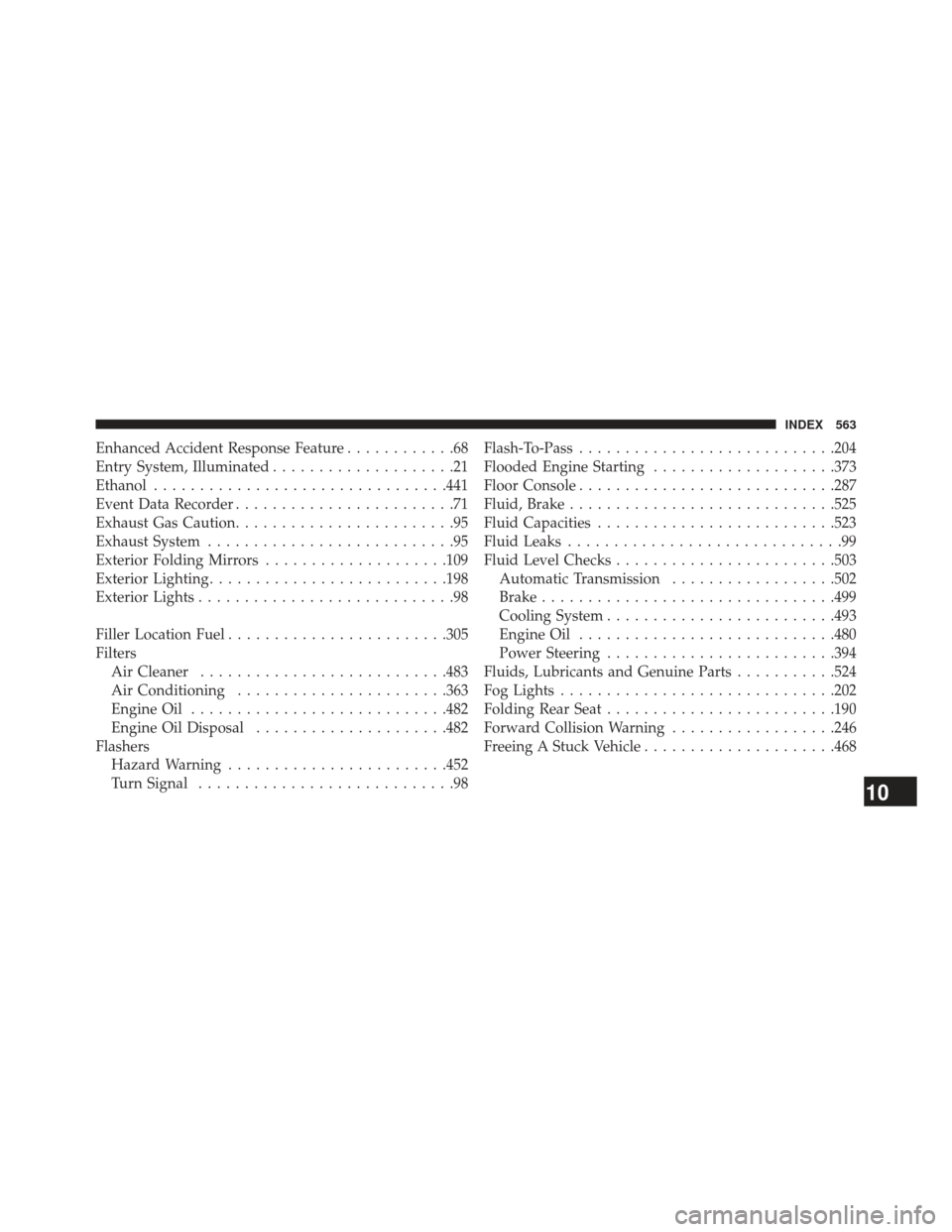
Enhanced Accident Response Feature............68
Entry System, Illuminated ....................21
Ethanol ............................... .441
Event Data Recorder ........................71
Exhaust Gas Caution ........................95
Exhaust System ...........................95
Exterior Folding Mirrors ....................109
Exterior Lighting ......................... .198
Exterior Lights ............................98
Filler Location Fuel ....................... .305
Filters Air Cleaner .......................... .483
Air Conditioning ...................... .363
Engine Oil ........................... .482
Engine Oil Disposal .....................482
Flashers Hazard Warning ....................... .452
Turn Signal ............................98 Flash-To-Pass
........................... .204
Flooded Engine Starting ....................373
Floor Console ........................... .287
Fluid, Brake ............................ .525
Fluid Capacities ......................... .523
Fluid Leaks ..............................99
Fluid Level Checks ....................... .503
Automatic Transmission ..................502
Brake ............................... .499
Cooling System ........................ .493
Engine Oil ........................... .480
Power Steering ........................ .394
Fluids, Lubricants and Genuine Parts ...........524
Fog Lights ............................. .202
Folding Rear Seat ........................ .190
Forward Collision Warning ..................246
Freeing A Stuck Vehicle .....................468
10
INDEX 563